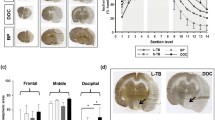In this study, a model of ischemic stroke by surgical proximal middle cerebral artery (MCA) occlusion was developed on 10 beagle dogs. The advantages of this model are the transtemporal approach and a minimally invasive surgical procedure. Dogs were randomly assigned to two groups: sham-operated (proximal MCA exposure without occlusion) and experimental (permanent proximal MCA occlusion) groups. Different evaluation methods were used to assess the consequences of MCA occlusion in dogs, including neurobehavioral tests, MRI, and immunohistochemical staining. Clear signs of cerebral infarction associated with the region supplied by MCA were confirmed and the model showed good repeatability and consistency. The model can serve as an appropriate large animal model to improve the translation of stroke therapeutics research from the laboratory to the clinical practice.
Similar content being viewed by others
References
Jickling GC, Sharp FR. Improving the translation of animal ischemic stroke studies to humans. Metab. Brain Dis. 2015;30(2):461-467. https://doi.org/10.1007/s11011-014-9499-2
Cirillo C, Brihmat N, Castel-Lacanal E, Le Friec A, Barbieux-Guillot M, Raposo N, Pariente J, Viguier A, Simonetta-Moreau M, Albucher JF, Olivot JM, Desmoulin F, Marque P, Chollet F, Loubinoux I. Post-stroke remodeling processes in animal models and humans. J. Cereb. Blood Flow Metab. 2020;40(1):3-22. https://doi.org/10.1177/0271678X19882788
Pagram H, Bivard A, Lincz LF, Levi C. Immunity and stroke, the hurdles of stroke research translation. Int. J. Stroke. 2017;12(2):123-131. https://doi.org/10.1177/1747493016676622
Sorby-Adams AJ, Vink R, Turner RJ. Large animal models of stroke and traumatic brain injury as translational tools. Am. J. Physiol. Regul. Integr. Comp. Physiol. 2018;315(2):R165-R190. https://doi.org/10.1152/ajpregu.00163.2017
Budras KD, McCarthy PH, Fricke W, Richter R, Horowitz A, Berg R. Anatomy of the Dog: An Illustrated Text. Hannover, 2007.
Corbett RJ, Purdy PD, Laptook AR, Chaney C, Garcia D. Noninvasive measurement of brain temperature after stroke. AJNR Am. J. Neuroradiol. 1999;20(10):1851-1857.
Cai B, Wang N. Large Animal Stroke Models vs. Rodent Stroke Models, Pros and Cons, and Combination? Acta Neurochir. Suppl. 2016;121:77-81. https://doi.org/10.1007/978-3-319-18497-5_13
Sommer CJ. Ischemic stroke: experimental models and reality. Acta Neuropathol. 2017;133(2):245-261. https://doi.org/10.1007/s00401-017-1667-0
Breuer L, Schwab S, Köhrmann M. Invasive stroke treatment — Study results and clinical routine : Lost in translation? Nervenarzt. 2016;87(8):821-828. https://doi.org/10.1007/s00115-016-0158-1
Stanzione R, Forte M, Cotugno M, Bianchi F, Marchitti S, Rubattu S. Role of DAMPs and of Leukocytes Infiltration in Ischemic Stroke: Insights from Animal Models and Translation to the Human Disease. Cell. Mol. Neurobiol. 2022;42(3):545-556. https://doi.org/10.1007/s10571-020-00966-4
Koizumi J, Yoshida Y, Nakazawa T, Ooneda G. Experimental studies of ischemic brain edema. 1. A new experimental model of cerebral embolism in rats in which recirculation can be introduced in the ischemic area. Japan. J. Stroke. 1986;8(1):1-8. https://doi.org/10.3995/jstroke.8.1
Atchaneeyasakul K, Guada L, Ramdas K, Watanabe M, Bhattacharya P, Raval AP, Yavagal DR. Large animal canine endovascular ischemic stroke models: A review. Brain Res. Bull. 2016;127:134-140. https://doi.org/10.1016/j.brainresbull.2016.07.006
Huang J, Mocco J, Choudhri TF, Poisik A, Popilskis SJ, Emerson R, DelaPaz RL, Khandji AG, Pinsky DJ, Connolly ES Jr. A modified transorbital baboon model of reperfused stroke. Stroke. 2000;31(12):3054-3063. https://doi.org/10.1161/01.str.31.12.3054
Tong FC, Zhang X, Kempf DJ, Yepes MS, Connor-Stroud FR, Zola S, Howell L. An Enhanced Model of Middle Cerebral Artery Occlusion in Nonhuman Primates Using an Endovascular Trapping Technique. AJNR Am. J. Neuroradiol. 2015;36(12):2354-2359. https://doi.org/10.3174/ajnr.A4448
Author information
Authors and Affiliations
Corresponding authors
Additional information
Translated from Byulleten’ Eksperimental’noi Biologii i Meditsiny, Vol. 174, No. 9, pp. 361-368, September, 2022
Rights and permissions
Springer Nature or its licensor (e.g. a society or other partner) holds exclusive rights to this article under a publishing agreement with the author(s) or other rightsholder(s); author self-archiving of the accepted manuscript version of this article is solely governed by the terms of such publishing agreement and applicable law.
About this article
Cite this article
Liu, J., Wang, Y., Yin, J. et al. A Canine Surgical Model of Stroke by Minimally Invasive Occlusion of the Proximal Middle Cerebral Artery. Bull Exp Biol Med 174, 370–375 (2023). https://doi.org/10.1007/s10517-023-05710-8
Received:
Published:
Issue Date:
DOI: https://doi.org/10.1007/s10517-023-05710-8




